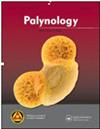澳大利亚东南部东塔斯马尼亚近海近9年来鞭毛藻囊肿的分布
IF 1.3
4区 地球科学
Q3 PALEONTOLOGY
引用次数: 1
摘要
摘要澳大利亚东南部的海水明显变暖,超过全球平均水平。该地区已成为研究现代和晚第四纪沉积物中浮游微化石,特别是鞭毛藻囊的战略位置,为研究中纬度水域的生物物理特性提供了重要的见解。本研究考察了澳大利亚东南部塔斯马尼亚州玛丽亚岛附近的海洋沉积物岩心中距今9000年(kyrs BP)的囊肿分布。优势包囊包括网状原角虫、原角虫属(avellana、conicum、oblongum、subinerme、shanghaiense)和刺虫属(bulloideus、hyperacanthus、膜虫属、mirabilis、厚皮虫属和ramosus)。近海以刺虫属(Spiniferites)占61%,近海以网纹虫属(P. reticulatum)占80%。Impagidinium spp.和Nematosphaeropsis迷路在约6 kyrs BP的近海被发现,表明它们从浅水生境向深水生境转变。tamarense亚历山Alexandrium species complex囊肿在近海存在140多年,近海存在近9年,表明其长期存在。大约50年前,裸子花囊仅在近海被发现,这表明了相对较近的水华现象。东澳大利亚洋流有限的向南延伸是由于缺少产生温水囊的分类群Lingulodinium polydra。同样,冷水物种Spiniferites antarctica和Impagidinium pallidum的未检出反映了亚热带锋界对南方亚南极入侵的抵制。与同一岩心的球石藻相比,没有观察到从冷水到温水的甲藻囊肿种类的明显变化。本文件的鞭毛藻囊肿有助于预测对当地社区和超越的环境影响。关键词:古气候,洋流,海平面上升,鞭毛藻囊,营养动力学,澳大利亚,澳大利亚,免责声明,作为对作者和研究人员的服务,我们提供这个版本的接受手稿(AM)。在最终出版版本记录(VoR)之前,将对该手稿进行编辑、排版和审查。在制作和印前,可能会发现可能影响内容的错误,所有适用于期刊的法律免责声明也与这些版本有关。本文章由计算机程序翻译,如有差异,请以英文原文为准。
Dinoflagellate cyst distribution over the past 9 kyrs BP from offshore east Tasmania, southeast Australia
AbstractSoutheastern Australia's marine waters are notably warming, surpassing global averages. This region has emerged as a strategic location for researching planktic microfossils, particularly dinoflagellate cysts, in modern and Late Quaternary sediments, offering crucial insights into the biophysical properties of mid-latitude waters. This study examined cyst distribution in marine sediment cores near Maria Island, Tasmania, southeastern Australia, up to 9,000 years before present (kyrs BP). Dominant cysts included Protoceratium reticulatum, Protoperidinium spp. (P. avellana, P. conicum, P. oblongum, P. subinerme, P. shanghaiense), and Spiniferites spp. (S. bulloideus, S. hyperacanthus, S. membranaceus, S. mirabilis, S. pachydermus, and S. ramosus). Inshore, Spiniferites spp. constituted a higher proportion (up to 61%), while offshore was dominated by P. reticulatum (up to 80%). Impagidinium spp. and Nematosphaeropsis labyrinthus were exclusively found offshore from ∼6 kyrs BP, suggesting a shift from shallow to deep-water habitat. Alexandrium tamarense species complex cysts were present over 140 years inshore and approaching 9 kyrs BP offshore, indicating a longstanding endemic presence. Gymnodinium catenatum cysts were detected exclusively inshore from ∼50 years ago, indicating a relatively recent bloom phenomenon.The East Australian Current's limited southward reach is suggested by the absence of warm-water cyst-producing taxa Lingulodinium polyedra. Similarly, the non-detection of cold-water species Spiniferites antarctica and Impagidinium pallidum reflects Subtropical Front boundaries against subantarctic incursions from the south. In contrast to coccolithophores in the same core, no noticeable shift from cold to warm-water dinoflagellate cyst species was observed. This documentation of dinoflagellate cysts aids in predicting environmental impacts on local communities and beyond.Keywords: PalaeoclimateOcean currentsSea level riseDinoflagellate cystsTrophic dynamicsTasmaniaAustraliaDisclaimerAs a service to authors and researchers we are providing this version of an accepted manuscript (AM). Copyediting, typesetting, and review of the resulting proofs will be undertaken on this manuscript before final publication of the Version of Record (VoR). During production and pre-press, errors may be discovered which could affect the content, and all legal disclaimers that apply to the journal relate to these versions also.
求助全文
通过发布文献求助,成功后即可免费获取论文全文。
去求助
来源期刊

Palynology
地学-古生物学
CiteScore
3.40
自引率
26.70%
发文量
48
审稿时长
>12 weeks
期刊介绍:
Palynology is an international journal, and covers all aspects of the science. We accept papers on both pre-Quaternary and Quaternary palynology and palaeobotany. Contributions on novel uses of palynology, review articles, book reviews, taxonomic studies and papers on methodology are all actively encouraged.
 求助内容:
求助内容: 应助结果提醒方式:
应助结果提醒方式:


